Sudoku
Two-away Jigsaw 8×8
Jul 20th
Continuing with Two-away puzzles, I thought today I’d post a somewhat smaller challenge – an 8×8 Jigsaw Sudoku version.
The rules are pretty much what you’d imagine: place 1 to 8 into each row, column and bold-lined jigsaw piece. Numbers with a grey bar between them must have a difference of 2 (e.g. 1&3) and numbers without a grey bar between must have a difference that’s not 2. (This is important to ensure a unique solution!)
Good luck! ![]()
Two-away Samurai Jigsaw
Jul 17th
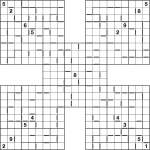
Two-away Samurai Jigsaw puzzle
Here’s a puzzle for the weekend – it’s a 5-grid samurai sudoku where in the corner grids a couple of the 3×3 regions have had their outlines tweaked to turn them into jigsaw sudoku puzzles, with full 8-way symmetry. There are very few givens, which means you’ll need to take full advantage of the two-away markers that are also in the grid. The grey rectangles indicate all neighbouring squares where the difference is 2 (e.g. 1&3 or 6&8) – even without precise values they can also be useful for quickly indicating where a chain of squares are all odd or all even.
Good luck! ![]()
Two-away Samurai Star
Jul 16th
I made this puzzle yesterday but then went and forgot to post it (oops) so I’m making up for that now! It’s a Samurai Star with two-away markers, just as per the previous two puzzles I posted.
Place 1 to 9 into each of the rows, columns and 3×3 boxes of the 5 underlying Sudoku grids (including the one in the centre), whilst obeying the two-away grey bars. Squares with a grey bar between have a difference of 2 (e.g. 1&3 or 2&4), and those without a grey bar have a difference which is not 2.
There are only 4 givens to get you going, so good luck! ![]()
Easy Two-away Sudoku
Jul 9th
I thought that yesterday’s puzzle wasn’t the best example of a new variant, so here’s an easier Two-away Sudoku puzzle. It has a few more connected squares which means the odd/even nature of the puzzle comes through a bit more clearly – if you’re familiar with consecutive sudoku then it probably won’t take you very long to solve.
The rules are as yesterday: place 1 to 9 into each row, column and 3×3 box, and then wherever a grey bar separates two squares the difference must be 2 – they must be “two-away” – and conversely where there is no grey bar then the difference is not 2.
Good luck! ![]()
Two-away Sudoku
Jul 8th
I just noticed that Monday marked my 50th post to garethmoore.co.uk, so to celebrate I thought I’d try a (slightly) new variation today: Two-away Sudoku. As its appearance might suggest, it is a close relative of Consecutive Sudoku. In fact it’s pretty much the same, except that the shaded grey bars indicate that the difference between neighbouring squares is 2 (not 1, as in Consecutive Sudoku). As in Consecutive Sudoku, all grey bars are drawn – so if one is absent then the difference is not 2.
For example, if you see a grey bar next to a square with ‘1′ in it then the neighbouring square must be ‘3′. However if you have a square with ‘1′ in and there is no grey bar between it and a neighbouring square then that square cannot contain ‘3′. It’s pretty simple really.
So – just place 1 to 9 into each row, column and 3×3 box whilst obeying the grey two-away markers!
Good luck! ![]()
Wrap-around Consecutive Samurai Star
Jul 6th
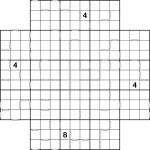
Wrap-around Consecutive Samurai Star puzzle
I seem to be posting more infrequently than I intend, so I thought I’d compensate with a puzzle that would take somewhat longer to complete! Here, then, is a wrap-around consecutive samurai star. All squares with consecutive values (a difference of 1) are marked with white bars, including those at opposite ends of rows and columns – wherever there isn’t a bar, the values are not consecutive.
The Sudoku logic takes a few twists here and there – in fact at one point near the end you will need to spot a particularly nasty hidden set in one region.
To solve the puzzle place 1 to 9 into each row, column and 3×3 box of each of the underlying 5 Sudoku grids (including the one in the centre). You’re only given 4 givens to get going, but with the consecutive information that’s all you need to find a unique solution.
Good luck! ![]()
(Non-consecutive) Consecutive Sudoku 12×12
Jun 30th
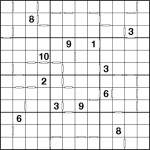
Consecutive 12×12 Sudoku puzzle
After a bit of a break to meet a major book deadline – the non-consecutive part of the title of this posting – I’m back with what seems to be one of the most popular types of puzzle, a Consecutive Sudoku. I wanted something a little bit different, though, so this is a Consecutive Sudoku 12×12. I personally always find Sudoku 12×12 pretty similar to regular 9×9 Sudoku to solve, unlike something like 16×16 which personally I’d never really bother with (apologies to anyone who loves them!).
In order to make the consecutive nature of the 12 possible values obvious, I’ve used one- and two-digit numbers rather than digits and letters. So the rules are simple: place 1 to 12 into each row, column and 4×3 box whilst obeying the white consecutive markers. Wherever there is a white consecutive marker between two squares then the difference of value in those two squares is 1; and conversely whereever there is no marker the difference is always greater than 1.
So sorry for the break – hopefully ‘normal’ service will now be resumed! ![]()
And good luck with the puzzle!
Skyscraper Sudoku 8×8
Jun 19th
Continuing my series of 8×8 Skyscrapers and variants, here’s an 8×8 Sudoku with Skyscraper clues around the edge.
The rules are simple:
- Place 1 to 8 in each row, column and 4×2 box
- Obey the Skyscraper constraints: each number outside the grid reveals the number of ‘visible’ digits looking along that row/column, where higher digits obscure lower ones
Good luck!
SSSS: Skyscraper Shuriken Samurai Sudoku
Jun 5th
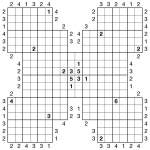
Skyscraper Shuriken Samurai Sudoku puzzle
I’m glad yesterday’s Shuriken Samurai went down well, so today I’ve upgraded it to a Skyscraper puzzle (following Christine’s request for more Skyscrapers!). This is, I think it’s fair to say, quite a bit harder than the basic Samurai yesterday was – but then any puzzle with a title this hard to say quickly really shouldn’t be able to be solved quickly either… ![]()
The rules are the same as yesterday (place 1-6 into each row, column and 2×3 box of the 13 underlying 6×6 Sudoku grids) but with the addition of Skyscraper constraints: place numbers so that the given number of digits can be ’seen’ from each external Skyscraper clue outside the grid. From the vantage point of each Skyscraper clue look along the adjacent row/column – with higher numbers obscuring all lower numbers (or those of the same value), the clue tells you how many numbers are visible. Check back to older puzzles I’ve posted for more detailed help.
Good luck! ![]()
Shuriken Samurai Sudoku
Jun 4th
Here’s a fun little puzzle. A say ‘little’ because it revolves around 6×6 grids and some easy logic, although it actually involves 13 of them so it’s not exactly small either. But I think it looks quite fun – the X shape and the X of givens makes it look a Japanese Shuriken weapon (or perhaps that’s just me), but anyway here it is.
Simply place 1-6 into each row, column and bold-lined 2×3 box of each of the 13 underlying 6×6 Sudoku grids.
Good luck! ![]()
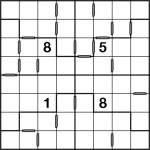
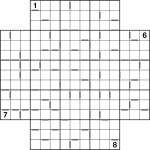
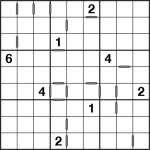
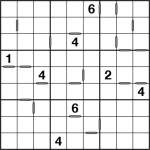
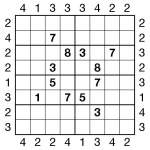
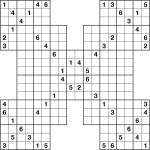

Recent Comments